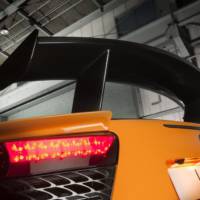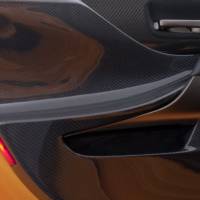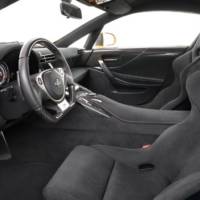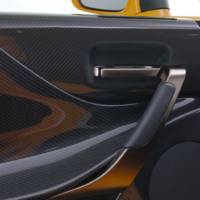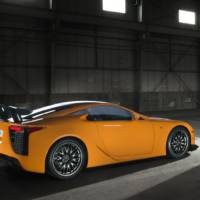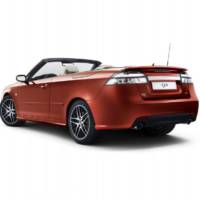Lexus has just published new photos and details for its limited edition Nurburgring package available as an option for the LFA.
A maximum of 10 cars will receive the exclusive Lexus LFA Nurburgring treatment, which turns the Japanese model into a more track-focused performance car, by increasing total output to 562 bhp (+ 10 bhp) and enabling a 0 to 62 acceleration time of 3.7 seconds.
The Lexus LFA Nurburgring makes use of Carbon Fibre Reinforced Plastic (CFRP) by featuring a series of components that help reduce downforce, like a larger front spoiler, fin-type side spoilers, a canard fin and a fixed rear wing.
The Lexus LFA Nurburgring package also includes a revised suspension which has been lowered by 10 mm, and double spoke design black alloys fitted with sticky performance tires.
Exterior colour choices are limited to matte black, black, white or
orange, while the interior is finished in black and red, black and purple and
all-black.
Those who purchase the Lexus LFA Nurburgring package will also receive a tuition course from a Nurburgring chief instructor, and a year’s pass on the famous German circuit.
Lexus press release :
* Lexus reveals special performance package for its LFA supercar at the Geneva motor show
* Nürburgring Package offered as an option on a maximum of 50 cars – just 10 per cent of the total LFA production run
* Designed for more track-focused performance through additional aerodynamic elements, lowered suspension and engine revisions
* 10bhp increase in power from V10 engine to 562bhp ensures LFA’s 0-62mph acceleration time of 3.7 seconds is maintained
* LFA production underway since December, with one hand-crafted car completed per day
* Use of advanced, automated Carbon Fibre Reinforced Plastic (CFRP) production processes serves as a test bed for future models
To celebrate the LFA’s hat-trick of class wins at the Nürburgring 24 Hours race, Lexus has created the Nürburgring Package, an array of aerodynamic features, suspension adjustments and revisions to the 4.8-litre V10 engine that give the supercar a more track-focused profile. Shown in public for the first time at the Geneva motor show, the performance option is available on just 50 of the 500 cars that will be built. These versions will be crafted during 2012, the second full year of LFA production.
To sharpen the car’s circuit driving performance even further by increasing downforce at high speed, the Nürburgring Package introduces modifications and additions to several key carbon fibre reinforced plastic (CFRP) components. These include a larger front spoiler, fin-type side spoilers, a canard fin and a fixed rear wing.
To ensure the LFA maintains its 3.7-second acceleration time from nought to 62mph, in spite of the increased drag, the V10 engine has been revised to increase maximum power by 10bhp to 562bhp. Shift times in the six-speed sequential transmission are just 0.15 seconds.
In terms of handling modifications, the package features suspension tuning and a 10mm reduction in the ride height. Exclusive mesh-type wheels are introduced, fitted with dedicated high-grip tyres.
Exterior colour choices are restricted to matte black, black, white or orange, with interiors finished in black and red, black and purple and all-black. Cars delivered in Europe will feature a carbon fibre centre console and door trims, with carbon fibre sports seats finished in Alcantara.
Customers who specify the package will also be offered one-to-one driving tuition from a Nürburgring chief instructor and a year’s pass to enjoy their car on the famous Nordschleife circuit.
CFRP parts manufacturing
LFA production began in December with just one hand-crafted car completed per day. A team of 175 people are involved in CFRP parts manufacturing, vehicle assembly and painting.
CFRP is exceptionally strong, rigid and lightweight, and accounts for about 65 per cent of the LFA’s body structure weight. This amounts to a saving of about 100kg, compared an equivalent all-aluminium body.
Lexus is producing and assembling the CFRP components in-house, with a view to future development of the technology. It is a time-consuming process, compared to working with steel or aluminium, but the LFA project provides a valuable test bed for new, automated processes which will be used in the manufacture of future Lexus and Toyota models.
Different manufacturing technologies are used according the shape, role and required properties of each component.
* Pre-preg: this is an industry-standard composite sheet material made of carbon fibre, pre-impregnated with epoxy resin. It is used for the LFA’s main structural elements, such as the dash, side and cross-members and panels.
* Resin Transfer Moulding (RTM): this is dry sheet fabrication, with epoxy resin injected into the mould. It is mainly employed in the LFA’s secondary main frames, such as the crash boxes, roof side rails and vehicle floor.
* Carbon fibre – Sheet Moulding Compound (C-SMC): this is used for fabricating the upper body components and frames that have complex geometries.
Adhesive bonding
The LFA assembly line moves through five consecutive processes, each of which has been digitally validated. For the first four – sub-assembly, underbody, small aluminium parts and main body – adhesive bonding is used. Final assembly of the aluminium parts is by mechanical fastening.
This is the first time Lexus has used adhesive bonding for main body assembly, a process that has required new quality control measures to be implemented to ensure each of the five stages involved in the bonding meets the required criteria.

23 Feb 2011
0



